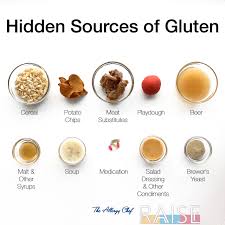The Lowdown on Gluten: What You Need to Know
Gluten has become a buzzword in the world of nutrition and health, but what exactly is it? Gluten is a protein found in wheat, barley, rye, and triticale. It acts as a binding agent, giving dough its elasticity and helping bread rise.
For most people, gluten is harmless and forms a staple part of their diet. However, for individuals with celiac disease or gluten sensitivity, consuming gluten can lead to a range of symptoms such as bloating, diarrhea, fatigue, and even damage to the small intestine.
With the rise in awareness of gluten-related disorders, many food manufacturers now offer gluten-free alternatives to cater to those with dietary restrictions. These products use alternative flours such as rice flour, almond flour, or coconut flour to replicate the texture and taste of traditional gluten-containing foods.
It’s important to note that going gluten-free is not necessarily healthier for everyone. In fact, some gluten-free products may be higher in sugar and fat to compensate for the lack of gluten. For individuals without gluten intolerance, there is no need to avoid gluten unless advised by a healthcare professional.
In conclusion, understanding your body’s response to gluten is key in making informed dietary choices. Whether you choose to embrace or avoid gluten, remember that balance and moderation are key components of a healthy lifestyle.
6 Essential Tips for Managing a Gluten-Free Diet
- Read food labels carefully to identify gluten-containing ingredients.
- Choose naturally gluten-free grains like quinoa, rice, and corn.
- Be cautious of cross-contamination in restaurants and at home.
- Explore gluten-free alternatives for baking, such as almond or coconut flour.
- Consult a healthcare professional if you suspect gluten intolerance or celiac disease.
- Stay informed about hidden sources of gluten in processed foods.
Read food labels carefully to identify gluten-containing ingredients.
When it comes to managing your gluten intake, a crucial tip is to read food labels carefully to identify gluten-containing ingredients. By scrutinizing labels for wheat, barley, rye, and triticale – common sources of gluten – you can make informed choices about what you consume. Additionally, keep an eye out for hidden sources of gluten in processed foods and additives. Being vigilant about reading food labels empowers you to navigate your diet effectively and avoid potential triggers if you have gluten sensitivity or celiac disease.
Choose naturally gluten-free grains like quinoa, rice, and corn.
When following a gluten-free diet, opting for naturally gluten-free grains such as quinoa, rice, and corn can be a nutritious and delicious choice. These wholesome grains not only provide essential nutrients like fiber and antioxidants but also offer a versatile base for creating a variety of flavorful dishes. By incorporating these gluten-free options into your meals, you can enjoy a diverse and satisfying diet while steering clear of gluten-containing grains that may trigger adverse reactions in individuals with gluten sensitivities.
Be cautious of cross-contamination in restaurants and at home.
When it comes to managing a gluten-free diet, being cautious of cross-contamination is crucial both in restaurants and at home. Even trace amounts of gluten can trigger reactions in individuals with celiac disease or gluten sensitivity. In restaurants, it’s important to communicate your dietary needs clearly to the staff and inquire about their practices to prevent cross-contact with gluten-containing foods. At home, maintaining separate cooking utensils, cutting boards, and countertops for gluten-free preparation can help minimize the risk of unintentional exposure to gluten. By staying vigilant and proactive about cross-contamination, individuals following a gluten-free diet can enjoy their meals safely and with peace of mind.
Explore gluten-free alternatives for baking, such as almond or coconut flour.
For those looking to reduce their gluten intake or cater to gluten sensitivities, exploring gluten-free alternatives for baking can be a game-changer. Ingredients like almond or coconut flour not only offer a delicious twist to traditional recipes but also provide a nutritious boost with their unique flavors and textures. Almond flour adds a nutty richness, while coconut flour brings a subtle sweetness, making them versatile options for creating delectable treats that everyone can enjoy, regardless of dietary restrictions.
Consult a healthcare professional if you suspect gluten intolerance or celiac disease.
It is essential to consult a healthcare professional if you suspect gluten intolerance or celiac disease. These conditions can have serious implications for your health and well-being, and a proper diagnosis is crucial for managing symptoms and making informed dietary choices. A healthcare provider can conduct the necessary tests to determine if gluten is the culprit behind your symptoms and provide guidance on how to navigate a gluten-free lifestyle if needed. Seeking professional advice ensures that you receive the appropriate care and support tailored to your specific needs.
Stay informed about hidden sources of gluten in processed foods.
It is crucial to stay informed about hidden sources of gluten in processed foods. Gluten can often be present in unexpected products such as sauces, seasonings, and even certain beverages. By reading labels carefully and being aware of common ingredients that contain gluten, you can avoid unintentional consumption of this protein. Staying vigilant and educating yourself about where gluten may hide in processed foods is essential for those with gluten sensitivities or celiac disease to maintain a gluten-free diet successfully.



